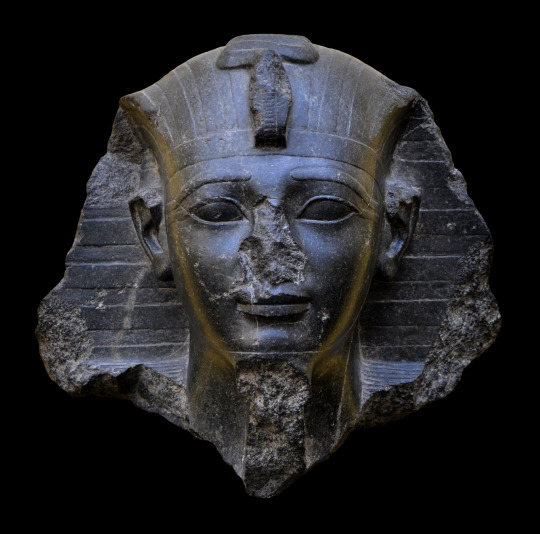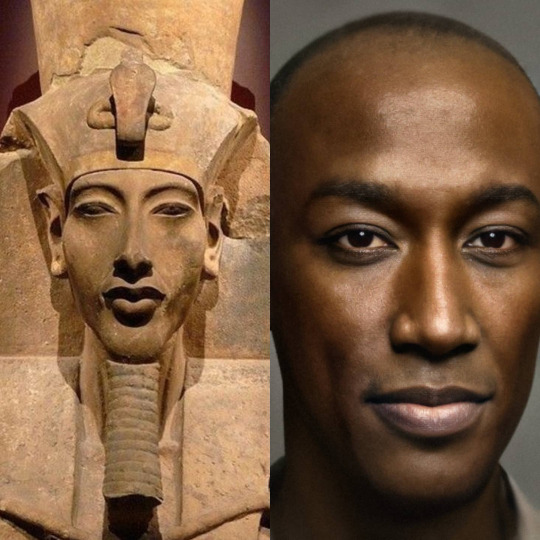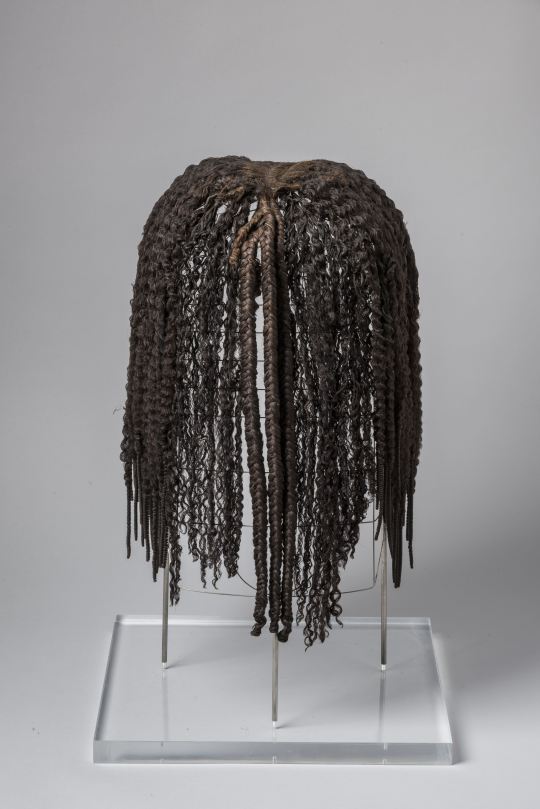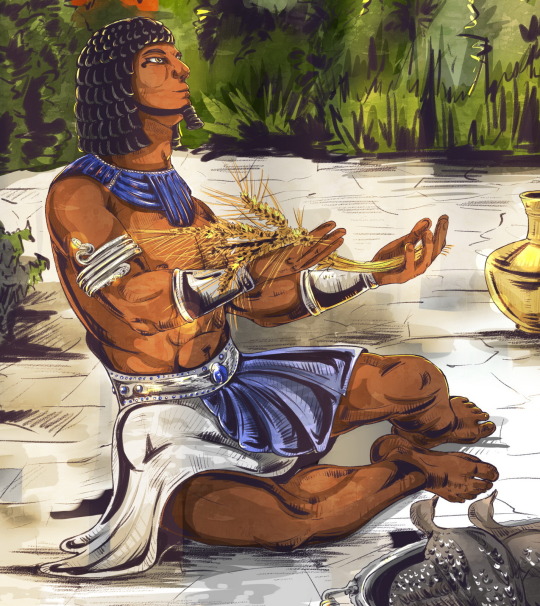#Amenhotep ii
Text

Kneeling Statue of Amenhotep II
New Kingdom, 18th Dynasty, ca. 1427-1401 BC.
From Temple of Amun-Re at Karnak.
Now in the Egyptian Museum of Turin. Cat. 1375
Read more
135 notes
·
View notes
Text

Amenhotep II
New Kingdom, 18th Dynasty, reign of Amenhotep II
Ny Carlsberg Glyptotek, Copenhagen, Denmark
Who was the Pharaoh of the Exodus? There are various theories. However, by examining the evidence found in ancient recorded history, it is surprisingly clear to establish just who the Exodus Pharaoh was. In "The Exodus Pharaoh EXPLAINED," Archeologist and Professor Joel Kramer shows us that Amenhotep II was indeed the Pharaoh of the Exodus.
#Amenhotep ii#egyptian#egypt#world history#bust#pharaoh#exodus#bible#art#history#amenhotep#joel kramer#the exodus#diorite#18th dynasty#new kingdom#ancient egypt#head of a pharaoh#background blacked out#ancient historian#roman#josephus
54 notes
·
View notes
Text
Amenhotep II and Rajendra Chola I
There are some similarities between Pharoah Hatshepsut and Ko-Parakesari Uttama Cholan.
Both became rulers during turbulent times.
In Chola country, there were some succession issues that are still unknown to us and a young heir (Aditha Karikalan) and the king (Parantaka II, Sundara Cholan) died back to back.
In Egypt, Thutmose II was a physically and mentally weak ruler who died young. His sister-wife (yes, incest 😫) and stepmother of his infant son Thutmose III, Hatshepsut, became the baby's co-regent and later independent King. She died when Thutmose III was 24.
Both stabilised the economies of their states and led administrative reforms.
They groomed their heirs very efficiently. Hatshepsut's stepson Thutmose the Great and Uttama Cholan's nephew Rajaraja the Great would go on to become extremely successful rulers.
Amenhotep II and Rajendra Cholan, the successors of these Kings, would try to malign the reputation of Hatshepsut and Uttama Cholan.
When he was made the co-regent at the end of his father's reign, Amenhotep II chiseled out or replaced Hatshepsut's cartouches (royal seal), destroyed pharonic statues and covered up her monuments. Rajendra Cholan's Thiruvalangadu copper plates say that "paternal uncle (Uttama Cholan) coveted his (i.e., Arunmolivarman's) dominions".
Why did these kings do it? Didn't Hatshepsut and Uttama Cholan bring their fathers (possibly Rajendran too) up and train them for well? If they were problematic, couldn't Thutmose III and Rajaraja I have outed them from power? Arulmozhi Varman was supposedly so beloved that people were begging him to become the king. Hatshepsut and probably Uttama too placed the army under the command of their heirs.
At the same time, we don't have any reason to believe that Hatshepsut and Uttama weren't nice and their successors were anything but respectful. Thutmose was actually really fond of his stepmother (which was ofc covered up Amenhotep). Rajarajan named his son Maduranthakan. We will revisit this at the end.
It is interpreted that the reasons weren't troubled past or personal relationships. It is the future, the legacy. It comes across as extremely conceited and arrogant but kings placed a lot of importance on their lineage. It is the sole thing that differentiated a random talented person from the king. Establishing a line of succession was only second to having the support of the army. If they didn't know much about ancestors or if they were unremarkable, kings would even claim the legacy of gods and mythological heroes.
By excluding Hatshepsut from the list of kings, Amenhotep established himself and his children as the legitimate successors of the throne.
Ahmose I - Amenhotep I- Thutmose I - Thutmose II - Hatshepsut - Thutmose III - Amenhotep II - Thutmose IV - Amenhotep III . . .
. . . you get the idea.
Similarly, by setting a narrative that the Chola crown always belonged to his father who magnanimously bestowed it upon the uncle temporarily, Rajendran ensured that he or his successors won't be troubled by Uttama's line.
Amenhotep and Rajendran didn't bear any personal grudge against Hatshepsut or Uttama.
Though Amenhotep tried to erase proof of Hatshepsut's reign as an independent king, her statues and inscriptions as the King's daughter, Chief Priestess of Amun and the Great Royal Wife were left intact. In fact he stopped those attempts too, immediately after he consolidated his rule.
Uttama Cholan is praised as an ideal man and king even in Thiruvalangadu plates and other inscriptions don't say anything bad about him.
Applying (his) mind to (the devotion of) Sarva (Siva), utilising (his) wealth in the act of performing his worship (employing) all (his) retinue in the construction of houses (i.e., temples) for him, and directing (his) subjects to (regularly) perform his festive processions, (showing his) wrath (only) in the killing of enemies and (distributing his) riches among virtuous Brahmanas, that king (Madhurantaka) bore on (his) broad shoulders, the (weight of the) earth.
Esalam copper plate, which was made at least after 25 years of rule (total reign 30 years).
Madhurantaka [Uttama], who wanted to re-establish on earth the auspicious path of justice that has slipped owing to the power of Kali.
But the story doesn't end here.
Sanskrit introduction of Leiden Plates aka Anaimangalam plates which is assumed to have been added later in Rajendran's reign praises him even more.
When that chief of kings went to heaven, the son of Gandaraditya, King Madhurantaka, he, of powerful arms and famous as Mahendran, protected the earth which had the ocean for its girdle.
The curious factor to be noticed here is that this grant doesn't mention the titles of either kings. Uttaman is mentioned as Maduranthakan and Rajarajan's son isn't Rajendran, Mummudi Cholan, Gangaikondan, or Kadaram Kondan- he is just another Maduranthakan. This might be the rare occasion of humility we see in him.
@willkatfanfromasia
@mizutaama
@vibishalakshman
@ambidextrousarcher
#ponniyin selvan#ponniyin selvan 2#arulmozhi#chola dynasty#rajaraja chola#Rajendrachola#uttamacholan#Uttamachola#Maduranthakan#ancient egypt#hatshepsut#Amenhotep ii#thutmose iii
18 notes
·
View notes
Text
Amenhotep II

View On WordPress
1 note
·
View note
Text
Ozymandias
Percy Bysshe Shelley
I met a traveller from an antique land,
Who said—“Two vast and trunkless legs of stone
Stand in the desert. . . . Near them, on the sand,
Half sunk a shattered visage lies, whose frown,
And wrinkled lip, and sneer of cold command,
Tell that its sculptor well those passions read
Which yet survive, stamped on these lifeless things,
The hand that mocked them, and the heart that fed;
And on the pedestal, these words appear:
My name is Ozymandias, King of Kings;
Look on my Works, ye Mighty, and despair!
Nothing beside remains. Round the decay
Of that colossal Wreck, boundless and bare
The lone and level sands stretch far away.”

The Colossi of Memnon - once reputed to sing at dawn (but not for many centuries!) The Singing Ringing Tree continues to perform for visitors.
#ozymandias#percy bysshe shelley#poetry#egypt#ramses II#memnon#amenhotep iii#hauteur#ruins#pride#boastfulness#hubris
11 notes
·
View notes
Text

Paint Box of Vizier Amenemope Egypt, Dynasty 18 -
(1540-1296 BC), Reign of Amenhotep II c. 1427-1401 BC
#treasures#Paint Box#Vizier Amenemope Egypt Dynasty 18#(1540-1296 BC)#Reign of Amenhotep II#c. 1427-1401 BC#ancient ways#art#palette
3 notes
·
View notes
Text
12 Facical Recreations Of Africa's Ancient Egyptian Pharaohs/Figures Based On Their Respective Sculptures
The 12 facial recreations of Africa’s ancient Egyptian pharaohs and figures based on their respective sculptures offer a captivating glimpse into the past. From the regal visage of Ahmose Nefertari to the serene countenance of Queen Tiye, each reconstruction brings history to life. The majestic presence of Amenhotep III and the enigmatic charm of Nefertiti are captured with remarkable precision.…

View On WordPress
#12 Ancient Egyptian Pharaohs Facical Recreations#African History#Ahmose Nefertari#Akhenaten#Amenemhat III#Amenhotep III#Ancient Egyptian Pharaohs Facical Recreations#Ancient Egyptians#ancient egyptians history#Djoser#Narmer#Nefertiti#Queen Tiye#Rameses II#Sahure#Senusret III#Tutankhamen
0 notes
Text




Tomb of Sennefer or Tomb of the Vineyards, in the Valley of the Nobles, Egypt.
Sennefer, his titles include Mayor of Thebes and “Inspector of the granaries and gardens of Amun”, during the reign of Amenhotep II (reigned from 1443 to 1417 BC) 18th Dynasty.
1K notes
·
View notes
Text

Face of Amenhotep II
The faces on most statues of Amenhotep II differ slightly from those of his two immediate predecessors. Compared with the sculpture of Thutmose III or Hatshepsut exhibited nearby, for example, this statue’s face is a little longer, the eyes somewhat narrower, the brows a bit straighter, the nose slightly thicker, and the mouth less curved.
This face is not a portrait, but an official image conceived by the chief royal sculptors to communicate the ideal physical appearance of Amenhotep II. The Egyptians believed that reality was momentary and thus, within the context of eternity, meaningless. Only an ideal representation would endure forever.
New Kingdom, 18th Dynasty, ca. 1426-1400 BC.
Now in the Brooklyn Museum. 56.7
Read more
108 notes
·
View notes
Text


Painted double statue of Sennefer & his mother or wife, Nenounhermenetes
New Kingdom, 18th Dynasty, reign of Amenhotep II, c. 1427-1401 B.C.
Musée du Louvre. E 27161
145 notes
·
View notes
Text

English👉🏻Paint Box of Vizier Amenemope. Egypt, Dynasty 18 (1540-1296 BC), reign of Amenhotep II, c. 1427-1401 BC
French👉🏻Boîte de couleurs du Vizir Amenemope.Egypte, Nouvel Empire, XVIIIème dynastie (1540-1296 av. J.C.), règne d'Amenhotep II
Musée d’Art de Cleveland, Ohio
#painting#abstraction#painters painting#abstract painting#art studio#collage#the painting space#art#photography#60s style
55 notes
·
View notes
Text





Merit’s wig - Museo Egizio Collection
Inventory Number: S. 8499
New Kingdom, Pre Ramesside, Dynasty 18. 1425–1353 BCE. Reign: Amenhotep II / Tuthmosis IV / Amenhotep III
Location Information: Deir el Medina / tomb of Kha (TT8)
Description:
Another exceptional artifact that belonged to Merit is her wig, made with real locks of hair that were sewn together and braided. The hair is parted in the middle and curled into ringlets that end with braids on either side of the face and on the back of the neck. This type of hairdo was often decorated with flowers and diadems, which were very fashionable in the mid-18th dynasty, as can be seen in the paintings and statues of the period.
#merit#new kingdom#new kingdom pr#S. 8499#museo egizio#deir el medina#tomb of kha#womens hair and wigs#NKPRWHW#upper egypt#wig#merits wig
70 notes
·
View notes
Text



Ahmose I (Ahmes I) was a pharaoh who reigned approximately 1550 - 1525 BC. e., and is the founder of the 18th dynasty.
He was never particularly popular or known and that’s the reason that made me draw this picture so that people would remember him or learn about him.
Ahmose's reign began on the day he came of age (at the age of 16), by which time his heroic father Seqenenra Taa II was already dead (he died not from intrigue, as you might think, but in a battle with the Hyksos). Ahmose's mother, Queen Yahhotep, initially ruled together with her son until he got married. Having blessed the couple to have a long and happy life, she finally retired from political affairs (not really).
Ahmose continued the war with the Hyksos because his father’s work had to continue and his death had to be avenged. The brave pharaoh set his sights on the very capital of his vile enemies. The young pharaoh entered into an alliance with Crete, which was famous for its unsurpassed fleet (And also for dancing with bulls and a centralized water supply, but that’s another story). He led the combined fleet to Avaris, a fortified city located on the Nile Delta, which made approaches to it from the river quite convenient. Nevertheless, the siege lasted for an indecently long time and only in the 11th year of the reign of Ahmose, the city was captured through a fierce assault. Many hands were cut off, and the water was stained with blood to the delight of the alligators. The unfortunate Hyksos were forced to retreat all the way to Asia, liberating all of Lower Egypt.
But this did not stop Ahmose. The thirst for revenge and the desire to protect Egypt from further encroachments by the Hyksos forced him to capture the Sharukhen fortress in Palestine. The last stronghold of his enemies fell.
All this time, Queen Yahhotep did not sit idle and actively helped her son in military activities, earning awards for her valor (perhaps we will talk about her in our next illustrations). Recapturing Egypt became the greatest deed in the life of Ahmose (which, you see, is quite impressive).
While the young pharaoh was engaged in his military activities (after all, as you know, once you start, it’s impossible to stop), his still fragile power over Egypt weakened. Uprisings began. However, they were successfully suppressed, thus finally strengthening him on the throne.
Finally, as he grew older, Ahmose’s ardor subsided and he began construction work. However, he was not so good in this field and practically not a single building of Ahmose has survived to this day. However, during his time new quarries were opened for the construction of temples, so everything is not so bad.
Ahmose's mother and grandmother were quite strong women who actively participated in political and even military activities until their last day. The first wife of Ahmose, Ahmose-Nefertari, also did not lag behind her relatives. All these women overshadowed Ahmose himself (we will not write about their deeds here). However, he loved his family and treated them with respect, which is reflected in some frescoes and in the records of scribes.
The painting reflects my interpretation of the fresco on the stele that Ahmose dedicated to his grandmother Tetisheri after her death. Here he makes offerings to her.
Ahmose died early, he was about 40 years old. After his death, his son Amenhotep I took the throne.
If you want to know more about this pharaoh, but don't want to read boring historical texts, there are works of fiction on the topic. Ahmose is the main character in Naguib Mahfouz's novel The War of Thebes and Christian Jacques's Wrath of the Gods trilogy. Both works tell the story of the liberation of Egypt from the rule of the Hyksos.
Artstation | Deviantart | VK | Commission List
#galgannet#illustration#ancient egypt#egyptian art#ancient history#egyptology#egyptian#Tetisheri#Ahmose I#Pharaoh Ahmose#древний египет.#Digital 2D#Comic Art#Illustration#pharaoh#Stylized#NoAI
47 notes
·
View notes
Text

Head of King Amenhotep II with the "Blue Crown"
Egyptian, 1427-1401 BCE (New Kingdom)
The khepresh, or "blue crown," appears frequently in royal sculpture of the New Kingdom. The king wore this crown on campaigns or in ceremonial processions. As with all royal headdresses, the coiled, protective uraeus serpent appears at the brow.
39 notes
·
View notes
Note
Fun fact about Atem and Abidos: Given the real life Pharaoh's they're supposedly based on, Amenhotep II and Tutankhamen respectively, Abidos is actually Atem's great-great-great-great-great grandson (or he can be Set's given that Atem died)! He and Jaden are technically cousins via adoption since Atem sees Jaden as his nephew, and it is highly likely that Jaden will pass onto the Field of Reeds since members of the Royal family get a free pass there no matter their crimes (looking at Aknadin here).
Also the Shadow Charm Abidos was given allows the dead to enter the realm of the living. Just imagine Atem finding out and thinking 'Seto could have waited a few years and Jaden would have given him the means for me to visit without him risking his life?!' or something.
This is all wonderful!! Thank you for sharing this information. I’m going to have to do research on those two pharaohs.
In cannon Jaden is the one collecting the shadow charms and I can just imagine him calling Atem after he gets a new one and the two of them trying to figure out what it does and where to store it.
Abidos charm has to frustrate him. Its power is allow the dead to enter the realm of the living… with their own body.
All he had to do to have his own body was find this shadow charm. His time sharing a body with Yugi will always be dear to both of them. But if they could have separated he could have protected Yugi and their friends better.
But he also has to laugh because of course one of the shadow riders was an Egyptian pharaoh. They are some of the best duelist. Until Jaden tells him that Abidos was not only a terrible duelist but was also proposed to him.
On one hand how dare an Egyptian pharaoh not be a good duelist. What was this kid’s court doing? It’s their job to prepare their pharaoh for what might come, not cater to his ego. (Yes the pharaoh had absolutely rule but when they were young it was the courts job to guide them.)
On the other who does this kid think he is proposing to Atem’s nephew. Yes Jaden is adopted but that doesn’t make him any less Atem’s nephew, and that makes him a prince of Egypt. Someone who will be welcomed into the Field of Reeds with open arms.
This Abidos, Atem had to look him up, was a far distant relative. To far down the line of Set’s dependents to actually hold any true connection to Atem. He was a minor pharaoh who had accomplished nothing with his short reign except the title ‘undefeated.’ Which turned out to be a lie?? Where did this pharaoh get the idea that he was good enough for Jaden? (Atem knows where it’s the idea that a pharaoh is always right and entitled to everything.) Well his nephew was to good for this fake duelist.
Arem is already communicating with Mahad about making sure this kid isn’t around when Jaden passes (he will most likely pass first and will be there to stop it himself but you have to make back up plans. Morbid back up plans) he’s quite frustrated when he learns that the young pharaoh is hanging out with his court, learning dueling, and waiting for Jaden.
He can’t be to mad. The kid is trying to improve his skills. But he’s going to have to improve a lot to make himself worthy of Atem’s nephew. And he better be ready. When Atem dies (the second time) he’s marching right up to him and challenging him to a duel. If he can’t beat Atem he won’t get near to Jaden.
28 notes
·
View notes
Text

Ancient Egypt, New Kingdom, Head from a Kneeling Figure of Amenhotep II, 1427-1400 BCE. Marble, 5 3/8" x 2 3/8" x 3 1/8" (13.6 x 6 x 8 cm). Museum of Fine Arts, Boston.
13 notes
·
View notes